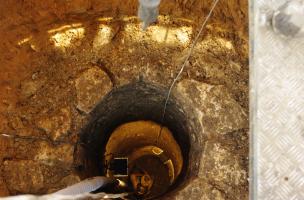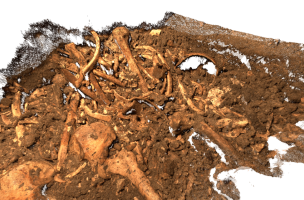You are here
A mysterious discovery at the bottom of a well at Entrains-sur-Nohain
Inrap has just completed five months of archaeological excavation at Entrains-sur-Nohain in advance of a private development project, curated by the State (Drac Burgundy). The 1000 m2 explored yielded part of the Antique town of Intaranum. The archaeologists unexpectedly discovered the remains of a mass grave, providing evidence of a massacre of a civil population.
To the north-west of the Aedui territory, at the intersection of a large Roman road network, the Antique town of Intaranum developed over the first four centuries of the modern era. At its apogee, it covered 120 hectares
On the outskirts of Intaranum

A gruesome discovery…
A very troubled period provides many clues
During the second third of the 9th century, Viking invasions also took place. They were in Paris in 845, Chartres and Beauvais in 858-859, and then descended the Rhone into Valence between 859 and 862. In the middle Rhone, Viking invasions took place in around 856 (pillaging of Orleans and the Abbey of Saint-Benoit-sur-Loire). While they mainly used drakkars, the Vikings did not hesitate to venture inland, as in the expedition of 856, which started in the Saintonge region and traversed the Massif Central to besiege Clermont-Ferrand.
Entrains-sur-Nohain is located less than 30 km from the banks of the Loire.
A period as disruptive as this could also have led to events such as plundering, which would have nothing to do with this significant event: a small, well-armed and determined band can easily overcome a village.
… or an epidemic?
Due to the complexity of this mass grave and its excavation, in situ observations are difficult. The well and the skeletons were thus modelled in 3D by the Captair company. This highly precise photogrammetric recording will enable further observations of these elements after the excavation.


Mahaut Tyrrell
Media communication
Inrap, media partnerships and relations
+33 (0)1 40 08 80 24
mahaut.tyrrell [at] inrap.fr
Inrap, interregional office Grand Est sud
+33 (0)6 72 56 28 51



